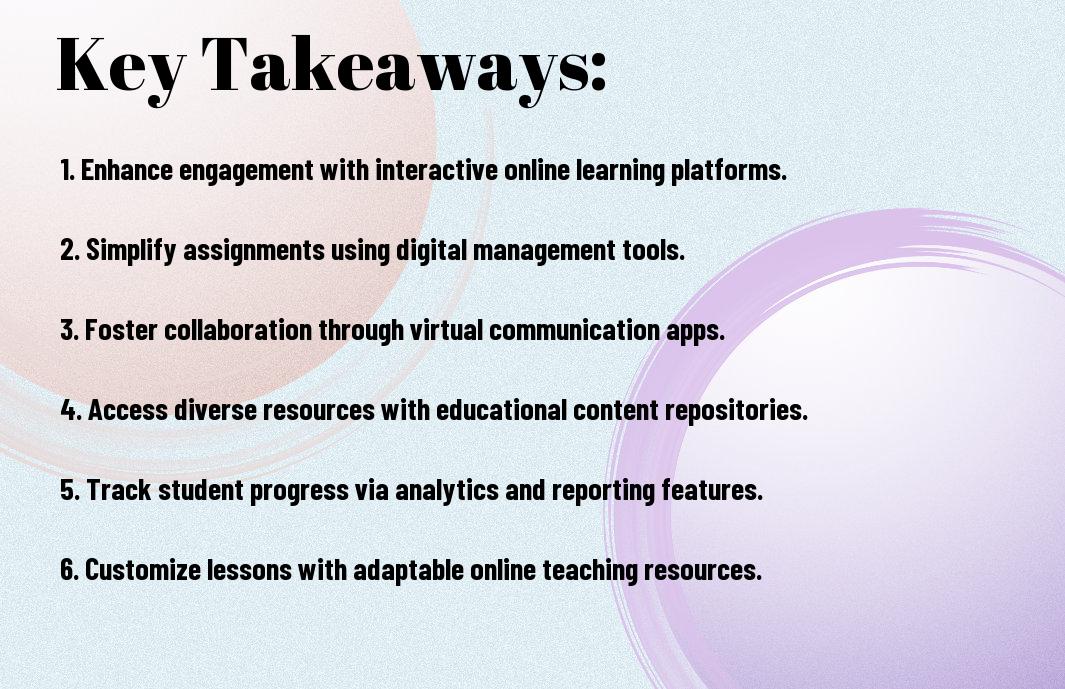As you navigate the ever-evolving landscape of education, you’re likely on the lookout for innovative ways to enhance your teaching practices and engage your students. Your quest for effective online tools can be daunting, but what if you had access to a curated list of the most impactful platforms and resources? You’re about to discover a treasure trove of online education tools that will revolutionize the way you teach and your students learn, making your job more efficient and enjoyable.
Key Takeaways:
To enhance the online learning experience, teachers can utilize various educational tools. Here are the main points to consider:
- The Learning Management System (LMS) is a vital platform for teachers to manage and deliver online courses, track student progress, and facilitate communication with students and parents.
- Virtual classroom tools, such as video conferencing software, enable teachers to conduct live online classes, interact with students in real-time, and create a more engaging learning environment.
- Online assessment tools allow teachers to create and administer quizzes, tests, and exams, providing an efficient way to evaluate student understanding and progress.
- Collaboration tools, including discussion forums and group project platforms, facilitate student interaction, teamwork, and peer-to-peer learning, promoting a sense of community in online courses.
- Content creation tools, such as multimedia authoring software, enable teachers to develop interactive and engaging educational content, including videos, podcasts, and presentations, to support student learning and understanding.
Effective Online Platforms
For teachers looking to enhance their online teaching experience, you can explore various platforms that cater to your needs. You can find more information on Software for Teachers > Online Education Tools to discover the best tools for your teaching practice.
Learning Management Systems
About the most popular learning management systems, you will find that they offer a range of features to support your teaching, from grading and assessment to communication and collaboration tools, making it easier for you to manage your online classroom.
Virtual Classrooms
Above all, virtual classrooms provide you with the flexibility to teach from anywhere, at any time, and offer your students a more immersive and engaging learning experience, which can be particularly beneficial for students who prefer online learning.
In addition, as you research deeper into virtual classrooms, you will discover that they offer a wide range of interactive tools, such as video conferencing, screen sharing, and live chats, allowing you to create a more dynamic and interactive learning environment that caters to the diverse needs of your students, enabling you to build a stronger connection with them and enhance their overall learning experience.


Interactive Tools
Assuming you want to create an engaging online learning experience, interactive tools are the way to go. You can use them to boost student participation, encourage discussion, and make learning fun. With interactive tools, you can create a dynamic online classroom that simulates real-world scenarios, making it easier for your students to understand complex concepts.
Quizzes and Polls
Between various interactive tools, quizzes and polls stand out as effective ways to assess student understanding and encourage participation. You can use these tools to create interactive assessments, gather feedback, and track student progress, helping you to refine your teaching methods and improve student outcomes.
Collaborative Documents
About to take your online teaching to the next level, collaborative documents are a great place to start. You can use these tools to create shared workspaces where students can collaborate on projects, share ideas, and work together in real-time, promoting teamwork and communication skills.
Also, as you explore deeper into collaborative documents, you’ll discover that they offer a range of features that facilitate seamless collaboration, such as real-time commenting, version control, and task assignment. You can use these features to guide your students, provide feedback, and monitor their progress, making it easier to manage group projects and ensure everyone is on the same page.
Multimedia Resources
Despite the abundance of online tools, selecting the right ones can be overwhelming. You can explore 🥇The 53 Best Free Online Teaching Tools in 2025 to discover a plethora of options tailored to your needs.
Educational Videos
One of the most effective ways to engage your students is through educational videos, which you can seamlessly integrate into your lesson plans to enhance their learning experience.
Interactive Simulations
Interactive simulations allow you to create immersive experiences, enabling your students to explore complex concepts in a virtual environment, making learning more enjoyable and effective.
Due to the versatility of interactive simulations, you can use them to teach a wide range of subjects, from science and math to language and history, helping your students develop a deeper understanding of the material and retain information better.
Assessment and Feedback
Once again, you’ll find that technology can greatly enhance your teaching practices, particularly when it comes to evaluating student performance and providing constructive feedback.
Online Quizzes and Tests
Around the clock, you can create and administer online quizzes and tests, using tools that automatically grade assignments and provide instant feedback to your students.
Peer Review Tools
Utilizing peer review tools, you can facilitate collaborative learning and encourage your students to learn from one another, developing vital critical thinking and communication skills.
Plus, with peer review tools, you can easily track student participation and engagement, identifying areas where your students may need extra support, and allowing you to tailor your teaching to meet their unique needs, ultimately helping you refine your instructional approach and improve student outcomes.
Student Engagement
All educators strive to create an environment that captivates their students’ attention and motivates them to learn. You can achieve this by leveraging various online tools that make learning fun and interactive, allowing you to track your students’ progress and adjust your teaching strategies accordingly.
Gamification and Rewards
For instance, you can utilize platforms that incorporate game design and rewards to encourage healthy competition and engagement among your students, making the learning process enjoyable and effective.
Discussion Forums
Encouragingly, online discussion forums enable you to facilitate meaningful conversations and debates, allowing your students to express their thoughts and opinions, and you to gauge their understanding of the subject matter.
Another significant aspect of discussion forums is that they provide a space for your students to collaborate on projects, share resources, and learn from one another, helping you to foster a sense of community and cooperation in your online classroom, and enabling you to assess their ability to work together towards a common goal.
Implementation and Support
To ensure a seamless integration of online education tools into your teaching practice, you’ll want to consider several key factors. Your goal is to create an environment where technology enhances learning, rather than hinders it.
Technical Requirements
On the heels of selecting the right tools, you’ll need to assess the technical capabilities of your classroom and school. Obviously, having the necessary hardware, software, and internet connectivity is crucial for a smooth implementation.
Teacher Training
The key to successful adoption lies in providing your teachers with the necessary training and support. You’ll want to ensure they are comfortable using the new tools and can effectively integrate them into their lesson plans.
Support for your teachers is vital as they navigate this new landscape. You’ll be helping them to develop the skills and confidence they need to make the most of these innovative tools, and in turn, enhance the learning experience for your students. As you consider the various online education tools available, think about how they can be used to supplement your existing curriculum and create a more engaging, interactive learning environment for your students. With the right tools and support, you can empower your teachers to take their instruction to the next level, and watch your students thrive as a result.
Summing up
The best online education tools for teachers are now at your fingertips, enabling you to create engaging lessons and track your students’ progress with ease. As you explore these tools, you’ll discover how they can enhance your teaching practices and make your job more efficient. With your newfound knowledge, you can harness the power of technology to inspire your students and take your teaching to the next level, making a lasting impact on their educational journey.
FAQ
Q: What are the best online education tools for teachers to enhance student engagement and participation?
A: The best online education tools for teachers include Learning Management Systems (LMS) like Canvas, Blackboard, and Moodle, which allow teachers to create and manage online courses, assign tasks, and track student progress. Additionally, interactive tools like Kahoot, Quizlet, and Padlet enable teachers to create engaging quizzes, games, and discussions that promote student participation and collaboration. Video conferencing tools like Zoom and Google Meet also facilitate virtual classroom interactions and remote learning.
Q: How can teachers effectively integrate online education tools into their teaching practices to support diverse learning needs?
A: Teachers can effectively integrate online education tools into their teaching practices by first identifying the specific learning objectives and needs of their students. They can then select tools that cater to different learning styles, such as visual, auditory, or kinesthetic. For example, teachers can use multimedia resources like videos, podcasts, and interactive simulations to support visual and auditory learners. They can also use tools like text-to-speech software and closed captions to support students with disabilities. Furthermore, teachers can use data analytics and tracking features in online tools to monitor student progress and adjust their instruction to meet the diverse needs of their students.
Q: What are some tips for teachers to ensure the safe and responsible use of online education tools in the classroom?
A: To ensure the safe and responsible use of online education tools, teachers should establish clear guidelines and expectations for online behavior and digital citizenship. They should also educate students about online safety, cyberbullying, and digital etiquette. Teachers can use built-in safety features in online tools, such as privacy settings and content filters, to protect students from inappropriate content. Additionally, teachers should regularly monitor student activity online and encourage students to report any concerns or incidents. By promoting a culture of digital responsibility and respect, teachers can create a safe and supportive online learning environment that fosters academic success and social growth.
